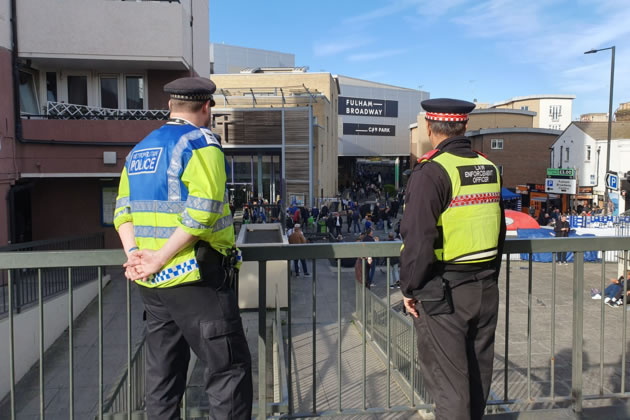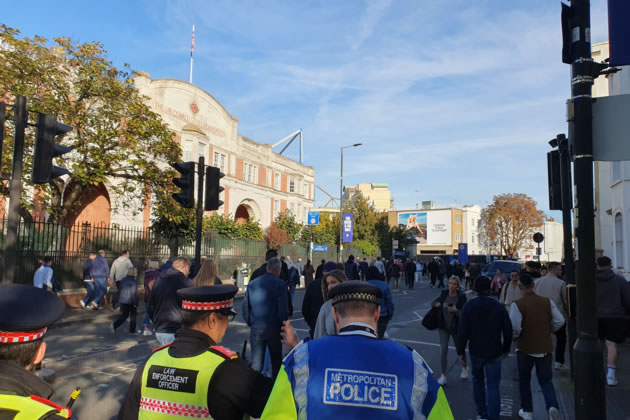Out on Patrol Ahead of Local Football Matches
Local team polices the three professional clubs in the borough

A Met Police officer and a law enforcement officer outside Stamford Bridge
November 4, 2024
Hammersmith and Fulham is home to not one, not two, but three professional football clubs. For one of the capital’s smallest boroughs, the tens of thousands of people attending home games at Chelsea, Fulham and Queens Park Rangers pose both significant benefits and potential headaches. Keeping the crowds, and those living and working nearby, safe and orderly is unsurprisingly a complex operation.
At Chelsea, which plays its home fixtures at Stamford Bridge by Fulham Broadway station, efforts involve not only the club’s officers and the Met Police also but the council’s own Law Enforcement Team (LET).
Launched in 2021 in a bid to make Hammersmith and Fulham a safer place, the 72 officers which comprise the LET act as the local authority’s eyes and ears on the ground. While unable to arrest anyone, they have powers including issuing fixed penalty notices and obtaining the name and address of offenders. Importantly, they gather intel to pass on to the Met Police and other emergency services, acting as an essential link in the borough’s crime-fighting network.
Following Hammersmith and Fulham Council’s introduction this summer of a new Public Spaces Protection Order (PSPO) clamping down on unwanted physical or verbal attention, LET officers can also now issue penalty notices for incidents including catcalling, flashing and sexualised comments.
Anyone who does not pay a fine can be taken to court, and potentially forced to fork out up to £1,000.
Ahead of the recent clash between Chelsea and Newcastle United at Stamford Bridge, the Local Democracy Reporting Service (LDRS) joined LET officers and the Met Police on a patrol of the area to witness this particular joint operation first-hand.
Sergeant Tom Upton, an Operational Football Officer at the Met who was deployed to patrol with the LET, said the team are integral to the work done on matchdays. “These guys are fantastic at what they do. Obviously they’re part of the council and we work really well together. I think we’re very lucky to have them. I don’t know of many other clubs that do this, I think it’s quite a unique model, and I think it works really well.”
Prior to heading out, the LET joined Chelsea while it debriefed its own officers on the plan for the day. Then, with about two hours to go before kick-off, they headed out to the streets.
Key to the LET and Met Police’s work is being seen patrolling and engaging. Described as ‘reassurance patrols’, one of the council’s law enforcement officers, Sagar Wagle, said: “We want to engage people first. So if they don’t want to listen…then our next step is action. But first our approach is engagement.”
This certainly seemed to be the order of the day during this particular patrol. While officers kept an eye out for anything suspicious, much of the work revolved around liaising with people in the area, even offering directions on more than one occasion, and making themselves seen.
In one instance a group of fans were asked to dispose of drinks they had on them, which they quickly complied with. That, however, was about as close as the day got to anything resembling an issue.

Patrol as fans walk along Fulham Broadway to a game
Mr Wagle, who joined the LET in 2022, said the most common problems officers deal with include littering, fly-tipping and people not walking/cleaning up after their dogs responsibly. On matchdays, they might also have to deal with issues such as people urinating in the street.
“Our regular job, the littering offences, any urination, or any public harassment. These are the kinds of things we do pre-match and post-match.”
Depending on what the LET team encounters, information can then be passed on to the council or other necessary authorities, with officers able to request cameras attached to their uniforms be monitored to provide real-time updates.
Alongside the CCTV network installed across the borough, reportedly the densest in the country, the ability to gather intel and quickly pass it on to the correct personnel is essential.
Weapon and drug sweeps are also a major part of the job. The LDRS previously accompanied LET officers around Shepherd’s Bush, in which they found items including discarded lighters and a crack pipe.
Mr Wagle recalled a recent incident when he attended an estate where a resident said they had been stabbed. He said he discovered a large bladed weapon hidden in a bush, which he passed on to the police.
As the day edged towards kick-off, the pre-match joint patrol ended with a walk through a nearby estate. Again, there was little in the way of nuisance. Mr Wagle had earlier explained how the mere presence of uniformed officers is understood to have reduced potential issues arising in the borough.
“When they see people in the uniform, they don’t behave [poorly]. So the people are more cheerful when they see us,” he said.
“When they see us, most of the time they don’t do it.”
Hammersmith and Fulham Council leader Stephen Cowan said: “Keeping people safe is our number one priority. In recent years, we have invested the largest ever amount into fighting crime and its causes and are spending more each year. To support the police, we have added a 72-strong Hammersmith and Fulham Law Enforcement Team. They patrol our streets, collect vital intelligence, initiate actions when crime hotspots emerge, and crack down on crime.
“Our LET officers are winning the war on local crime. Their support has helped cut the number of antisocial behaviour complaints to the Met Police from 8,480 in 2021 to fewer than 6,800 in 2023.”
Ben Lynch - Local Democracy Reporter